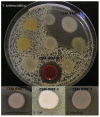Inhibition of Foodborne Pathogenic Bacteria by Excreted Metabolites of Serratia marcescens Strains Isolated from a Dairy-Producing Environment
- PMID: 36838368
- PMCID: PMC9959323
- DOI: 10.3390/microorganisms11020403
Inhibition of Foodborne Pathogenic Bacteria by Excreted Metabolites of Serratia marcescens Strains Isolated from a Dairy-Producing Environment
Abstract
Serratia marcescens strains from a dairy-producing environment were tested for their inhibitory effect on Listeria monocytogenes, Salmonella Hartford, Yersinia enterocolitica and Escherichia coli. Inhibition of foodborne pathogens was observed in the case of a non-pigmented Serratia strain, while the pigment-producing isolate was able to inhibit only Y. enterocolitica. The co-culturing study in tryptone soya broth (TSB) and milk showed that the growth of Salmonella was inhibited in the first 24 h, but later the pathogen could grow in the presence of the Serratia strain even if its cell concentration was 1000 times higher than that of Salmonella. However, we found that (1) concentrated cell-free supernatants had stronger inhibitory activity, which confirms the extracellular nature of the antagonistic compound(s). We proved that (2) protease and chitinase enzymes can take part in this mechanism, but they are not the main inhibitory compounds. The presence of prodigiosin was observed only in the case of the pigmented strain; thus, (3) we hypothesized that prodigiosin does not take part in the inhibition of the pathogens. However, (4) the combined effect of different extracellular metabolites might be attributed to the inhibitory property. Application of concentrated S. marcescens cell-free supernatant can be an effective antibacterial strategy in the food industry, mainly in the form of a bio-disinfectant on surfaces of food-processing areas.
Keywords: antibacterial activity; extracellular metabolites; food safety; hydrolytic enzymes; natural antimicrobials; prodigiosin.
Conflict of interest statement
The authors declare no conflict of interest.
Figures





Similar articles
-
Broad-spectrum antimicrobial activity of secondary metabolites produced by Serratia marcescens strains.Microbiol Res. 2019 Dec;229:126329. doi: 10.1016/j.micres.2019.126329. Epub 2019 Sep 4. Microbiol Res. 2019. PMID: 31518853
-
Prodigiosin, Violacein, and Volatile Organic Compounds Produced by Widespread Cutaneous Bacteria of Amphibians Can Inhibit Two Batrachochytrium Fungal Pathogens.Microb Ecol. 2018 May;75(4):1049-1062. doi: 10.1007/s00248-017-1095-7. Epub 2017 Nov 9. Microb Ecol. 2018. PMID: 29119317
-
The Kiss of Death: Serratia marcescens Antibacterial Activities against Staphylococcus aureus Requires Both de novo Prodigiosin Synthesis and Direct Contact.Microbiol Spectr. 2022 Jun 29;10(3):e0060722. doi: 10.1128/spectrum.00607-22. Epub 2022 Apr 18. Microbiol Spectr. 2022. PMID: 35435740 Free PMC article.
-
Prodigiosin inhibits bacterial growth and virulence factors as a potential physiological response to interspecies competition.PLoS One. 2021 Jun 23;16(6):e0253445. doi: 10.1371/journal.pone.0253445. eCollection 2021. PLoS One. 2021. PMID: 34161391 Free PMC article.
-
SELECTIVE INHIBITION OF PROLINE-INDUCED PIGMENTATION IN WASHED CELLS OF SERRATIA MARCESCENS.J Bacteriol. 1963 May;85(5):1136-40. doi: 10.1128/jb.85.5.1136-1140.1963. J Bacteriol. 1963. PMID: 14044006 Free PMC article.
Cited by
-
Prodigiosin-Producing Serratia marcescens as the Causal Agent of a Red Colour Defect in a Blue Cheese.Foods. 2023 Jun 16;12(12):2388. doi: 10.3390/foods12122388. Foods. 2023. PMID: 37372599 Free PMC article.
-
Molecular Characterization of Serratia marcescens Strain Isolated from Yellow Mealworms, Tenebrio molitor, in The Netherlands.Insects. 2023 Sep 16;14(9):770. doi: 10.3390/insects14090770. Insects. 2023. PMID: 37754738 Free PMC article.
-
Antimicrobial Mechanism of Salt/Acid Solution on Microorganisms Isolated from Trimmed Young Coconut.Microorganisms. 2023 Mar 29;11(4):873. doi: 10.3390/microorganisms11040873. Microorganisms. 2023. PMID: 37110296 Free PMC article.
References
-
- McIntyre L., Hudson J.A., Billington C., Withers H. Biocontrol of foodborne bacteria: Past, present and future strategies. Food New Zealand. 2007;7:25–36.
-
- Yang H., Cheng J., Hu L., Zhu Y., Li J. Mechanisms of antimicrobial resistance in Serratia marcescens. Afr. J. Microbiol. Res. 2012;6:4427–4437. doi: 10.5897/AJMR11.154. - DOI
Grants and funding
LinkOut - more resources
Full Text Sources
Molecular Biology Databases

